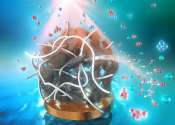Li-ion batteries: Science 'directly into your hand'
They are omnipresent and essential to navigating modern life. Small, light, rechargeable: lithium ion batteries have revolutionised our world in less than three decades.
Oct 9, 2019
0
227
Energy & Green Tech

They are omnipresent and essential to navigating modern life. Small, light, rechargeable: lithium ion batteries have revolutionised our world in less than three decades.
Oct 9, 2019
0
227
Engineering

A line is the shortest distance between two points, but "A-line," a 4-D printing system developed at Carnegie Mellon University, takes a more circuitous route. One-dimensional, "line"-shaped plastic structures produced with ...
Oct 7, 2019
0
235
Energy & Green Tech

A future powered by carbon-free fuel depends on our ability to harness and store energy from renewable but intermittent sources, such as solar and wind. Now, a new catalyst developed at University of Toronto Engineering gives ...
Dec 12, 2018
0
430
Engineering

Its name is an acronym used to convey its size, but researchers at Cornell Engineering and Weill Cornell Medicine are hoping their hand-held cancer detection device's impact in the developing world is anything but small.
Sep 17, 2018
0
71
Energy & Green Tech

MSU scientists have a new proof of concept for a biofuel production platform that uses two species of marine algae and soil fungi. It lowers cultivation and harvesting costs and increases productivity, factors that currently ...
Sep 13, 2018
0
276
Energy & Green Tech

A team of engineers has developed stretchable fuel cells that extract energy from sweat and are capable of powering electronics, such as LEDs and Bluetooth radios. The biofuel cells generate 10 times more power per surface ...
Aug 22, 2017
1
36
Energy & Green Tech

It's always exciting to bring home a new smartphone that seems to do anything, but it can be all downhill from there. With every charge and discharge cycle, the device's battery capacity lowers a little bit more—eventually ...
Jan 23, 2017
1
12
Energy & Green Tech

Lithium-ion batteries have been at the forefront of energy storage technologies. However, the availability of lithium is limited. Consequently, the growing demand for energy-storage systems has led to the search for low-cost ...
May 28, 2024
0
45
Energy & Green Tech

A research team has successfully developed dual-site radioactive isotope dye-sensitized betavoltaic cells, a next-generation semi-permanent battery that does not require recharging.
May 20, 2024
0
30
Energy & Green Tech

Aerobic treatment of industrial wastewater from the pulp and paper industry is the most expensive treatment step in the purification process. New research published in Environmental Technology & Innovation shows how the purification ...
Mar 5, 2024
0
2
An acid (from the Latin acidus/acēre meaning sour) is a substance which reacts with a base. Commonly, acids can be identified as tasting sour, reacting with metals such as calcium, and bases like sodium carbonate. Aqueous acids have a pH of less than 7, where an acid of lower pH is typically stronger, and turn blue litmus paper red. Chemicals or substances having the property of an acid are said to be acidic.
Common examples of acids include acetic acid (in vinegar), sulfuric acid (used in car batteries), and tartaric acid (used in baking). As these three examples show, acids can be solutions, liquids, or solids. Gases such as hydrogen chloride can be acids as well. Strong acids and some concentrated weak acids are corrosive, but there are exceptions such as carboranes and boric acid.
There are three common definitions for acids: the Arrhenius definition, the Brønsted-Lowry definition, and the Lewis definition. The Arrhenius definition states that acids are substances which increase the concentration of hydronium ions (H3O+) in solution. The Brønsted-Lowry definition is an expansion: an acid is a substance which can act as a proton donor. Most acids encountered in everyday life are aqueous solutions, or can be dissolved in water, and these two definitions are most relevant. The reason why pHs of acids are less than 7 is that the concentration of hydronium ions is greater than 10−7 moles per liter. Since pH is defined as the negative logarithm of the concentration of hydronium ions, acids thus have pHs of less than 7. By the Brønsted-Lowry definition, any compound which can easily be deprotonated can be considered an acid. Examples include alcohols and amines which contain O-H or N-H fragments.
In chemistry, the Lewis definition of acidity is frequently encountered. Lewis acids are electron-pair acceptors. Examples of Lewis acids include all metal cations, and electron-deficient molecules such as boron trifluoride and aluminium trichloride. Hydronium ions are acids according to all three definitions. Interestingly, although alcohols and amines can be Brønsted-Lowry acids as mentioned above, they can also function as Lewis bases due to the lone pairs of electrons on their oxygen and nitrogen atoms.
This text uses material from Wikipedia, licensed under CC BY-SA